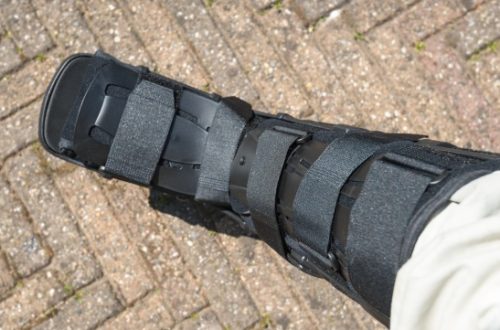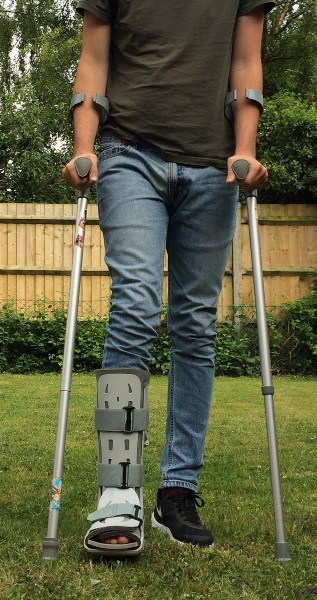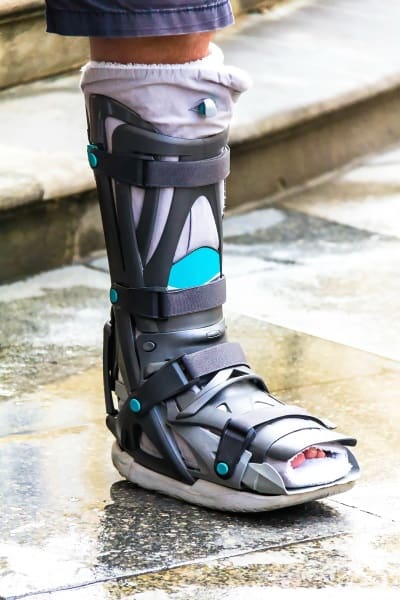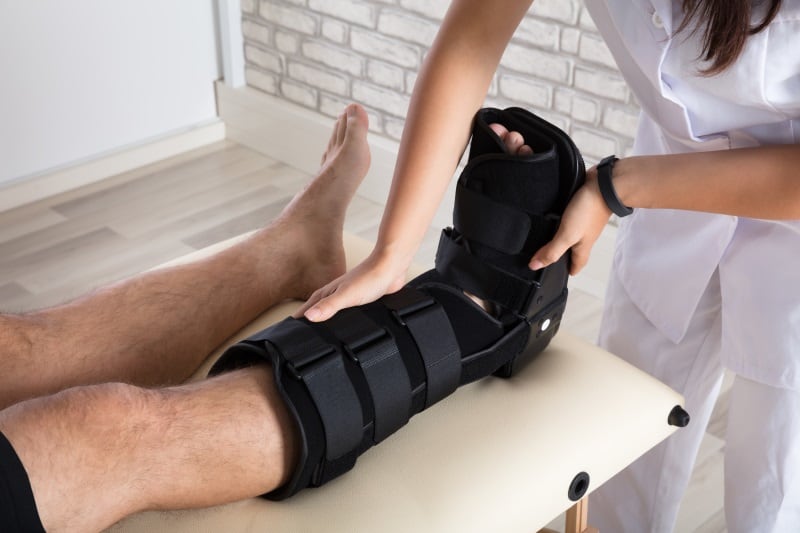Controlled Ankle Motion (CAM) walker boots and shoes are sometimes advised for plantar fasciitis sufferers depending on the severity of the condition.
Do you need a CAM walker boot for plantar fasciitis?
People who have suffered a major plantar fascia tear, rupture or had surgery, may be advised to wear a CAM walker boot during the initial stages of recovery. The boot is designed to limit the movement and prevent weight being applied to the damaged foot.
This article will look deeper into whether you need a walker boot, and the different types available to suit your condition.
What are CAM Walker Boots?
Walker boots, sometimes also referred to as a cast or brace, are designed to fit over the foot, ankle and lower leg to help protect and support the damaged area of the foot. Walker boots are not only used by plantar fasciitis sufferers, but can be used to help any foot, ankle or lower leg type injury such as Achilles tendonitis, broken foot or ankle, sprains etc.
What does CAMS Mean
CAMS is an acronym for Controlled Ankle Motion which, as it sounds, means limiting the movement of the ankle or foot to help promote recovery.

Do I Need A Walker Boot?
If you are in the acute (early) stages of plantar fasciitis, then you will not need a walker boot as icing, rest and stretching should be sufficient to see you on the road to a swift recovery.
If you have been dealing with plantar fasciitis for a prolonged period of several months or more, then you are now into the chronic stages of the condition and may need some assistance in your recovery process.
If you have found that even after diligently following a plantar fascia recovery routine involving rest, massaging and stretching, you are not seeing improvement or the condition has got worse, then you may need to consider alternatives.
Compression socks, night splints and orthotic aids such as insoles are probably worth trying before investing in a walker boot.
If you are finding it extremely painful to walk for a significant duration of time ie: the pain is not subsiding after a few minutes of walking, then you may want to consider trying a walker boot to relieve the weight being applied to the foot.
If you have suffered a plantar fascia major tear or rupture, then you will almost definitely need to use a walker boot to prevent further damage and allow recovery to take place.
Depending on the severity of your injury, you may also be required to walk with crutches to prevent putting weight onto the boot in the initial stages of recovery.
Read our article on Plantar Fasciitis Orthotic Aids

Are there different types of walker boots?
There are several kinds of walker boot and the type of injury you are dealing with will determine which boot is best suited to your needs.
Standard Walker Boots
The most common type of walker boot is one that is made up of a foam insert and protective outer casing that is adjusted with velcro straps to fit your leg. These boots will help reduce the movement of the foot and ankle as well as providing support when weight is added.
These walker boots usually come in 3 sizes – ankle height, calf height and knee height.
The location of the injury will determine which height of boot you will require.
For plantar fasciitis you will probably only need the ankle or calf boots unless your problem stems from further up the leg.
Air Filled Walker Boot
These walker boots look very much like the standard walker boot but have air pockets built within them to provide further stability and support. Once the boot has been fitted, the air pockets are inflated giving a more snug feeling to the boot.
These air filled boots are highly effective for injuries where movement of the foot or ankle needs to be restricted as much as possible. The different air chambers can be inflated or defalted to provide just the right amount of support in the areas needed most.

Will My doctor provide a walker boot?
Depending on where you live, the type of insurance you have, you may be provided with a walker boot by your medical facility.
If you are told you require a boot by your doctor, find out whether this will be provided free of charge or if you have to pay.
If you are expected to pay for the boot, find out the boot model they will provide and price you will have to pay.
There are many places online that sell CAM walker boots and it may be cheaper to buy your own boot online rather than paying the price your facility is charging.
If you are able to purchase the boot cheaper online, simply tell your doctor that you will provide your own boot and arrange an appointment to have the boot fitted by them.
3 Recommended CAM Walker Boots to Consider
How long should I wear my walker boot?
If you have been prescribed the use of a walker boot by your medically trained practitioner, then they will also advise you on how long and often you need to be wearing the boot. Some injuries require you to wear the boot 24hrs a day for the initial stages of recovery.
It is vitally important that you follow the medical advice you are given as non-compliance can further complicate matters and prolong your recovery. Some medical advisors are against offering the use of a walker due to patients not adhering to their instructions [source]
If you are deciding to try a walker boot as part of your own home remedy strategy, then it is probably advisable to wear the boot as often as you feel able.
Most certainly you will want to wear it throughout the daytime to prevent you from putting weight onto the damaged foot.
Whether you decide to wear the boot while you sleep will be a matter of comfort and preference.
How long will I need a walker boot?
Again, if you are wearing the boot under the recommendation of a medically trained advisor, then you will no doubt be given a guide to the length of time they expect it to be worn.
You will no doubt go for follow up evaluations and your progress will ultimately determine the full length of time you will need to continue wearing the boot.
If you are wearing the walker boot as part of your own recovery, then you will be able to determine your own progress.
If you feel that your foot has gotten significantly better with the use of the boot, you could try reducing the time that you are wearing it to see how you get on.
Gently reduce the time you are wearing the boot and gradually begin to build up the lost muscles and strengthen the plantar fascia with gentle stretching exercises.
Follow our 5 Minute Stretching Routine For Faster Plantar Fasciitis Recovery
How To Fit A CAM Walker Boot
This video explains how to fit a walker boot and the advantages of having the inflatable air pockets
https://www.youtube.com/watch?v=rZTsrNnNFuw
Tips for Using A Walker Boot
- Make sure you get the correct size boot for your needs, both in terms of shoe size and height (ankle, calf, knee)
- Don’t buy an expensive air boot if a standard non-air cushioned boot will get the job done
- Try to prevent getting the boot wet. Wrap the boot in a plastic trash bag or boot cover when taking a shower or going out in wet weather
- Wear long socks, leggings or other thin clothing between the boot liner and your leg to prevent rubbing
- Wear some kind of antiperspirant, talcum powder or moisture barrier to reduce sweating
- Wear a thick soled shoe on your good foot to compensate for the boot height and reduce the need for limping






